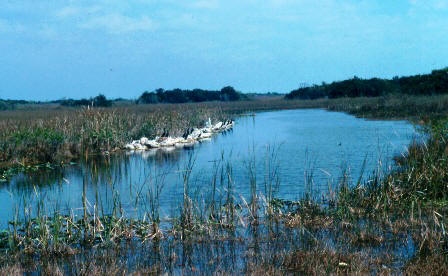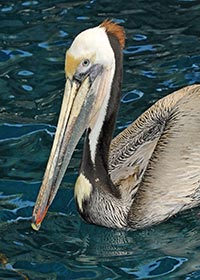Discover Florida Nature
It's time to explore the natural Florida


|
|
|
|
|
 Inshore
Marine Habitats are part of the Coastal Ecosystem. Florida's coastal
ecosystems are one of the greatest assets that Florida has. With more
coastline than any other state in the contiguous United States, they are
a source of both economic, environmental and recreational benefit.
People come from all over the world to visit the beautiful Florida
beaches. In addition to people
sea turtles also come from all over the world to lay their eggs on
Florida's Atlantic coast, one of only a handful of places in the world
that they come. The inshore marine habitats of Florida represent a
diverse, highly productive series of biological systems. Areas such as
the Everglades and Florida Bay are
unique in the northern hemisphere. Numerous species of economic
importance are closely associated with specific basin features,
climatological conditions, and water quality characteristics of
Florida's inshore systems. Inshore
Marine Habitats are part of the Coastal Ecosystem. Florida's coastal
ecosystems are one of the greatest assets that Florida has. With more
coastline than any other state in the contiguous United States, they are
a source of both economic, environmental and recreational benefit.
People come from all over the world to visit the beautiful Florida
beaches. In addition to people
sea turtles also come from all over the world to lay their eggs on
Florida's Atlantic coast, one of only a handful of places in the world
that they come. The inshore marine habitats of Florida represent a
diverse, highly productive series of biological systems. Areas such as
the Everglades and Florida Bay are
unique in the northern hemisphere. Numerous species of economic
importance are closely associated with specific basin features,
climatological conditions, and water quality characteristics of
Florida's inshore systems. SUBSTRATE: Mixtures of sand, silt, clay, and shell fragments. TOPOGRAPHY: Low-lying, coastal areas covered by shallow water. VEGETATION / ALGAE: Submerged sea grass beds are one of the most productive and important habitats of inshore marine systems; these beds are also substrates for epiphytic (attached) algae, an important component of the sea grass food web. FAUNA: Benthic (bottom) organisms determine to a considerable degree the community that lives in overlying water column; many fish and invertebrate species spend all or part of their life cycle in these habitats; shrimp, blue crabs, and spotted seatrout are examples of especially important recreational and commercial species; oysters are concentrated in inshore areas along the Gulf coast, particularly the Apalachicola estuary. PROCESSES / DYNAMICS / ABIOTIC FACTORS: Habitats contain sea water diluted by land runoff; water temperature, salinity, and dissolved oxygen are important determiners of species' diversity and overall ecosystem productivity. NEGATIVE IMPACTS: Upland restrictions of freshwater flow; removal of wetlands and grass beds; pollution from industrialization, urbanization, recreation, and agriculture.  Florida
Bay is a triangular, tropical lagoon/bay which occupies a shallow, rocky
trough between the relic, exposed barrier reefs of the Florida Keys and
a series of mangrove-lined bays and sounds at the southern end of the
Florida peninsula. Inshore marine areas in the Florida Bay estuary are
of two types. The first are grass-bottomed areas covered with turtle
grass and shoal grass. Turtle grass is the most important plant in the
food chain in these areas. They are among the most productive ecosystems
in the marine environment, rivaling those of tropical rain forest and
tidal marshes. It provides shelter and nutrients for juvenile shrimp,
crabs, young marine fish, and
loggerhead turtles. Florida
Bay is a triangular, tropical lagoon/bay which occupies a shallow, rocky
trough between the relic, exposed barrier reefs of the Florida Keys and
a series of mangrove-lined bays and sounds at the southern end of the
Florida peninsula. Inshore marine areas in the Florida Bay estuary are
of two types. The first are grass-bottomed areas covered with turtle
grass and shoal grass. Turtle grass is the most important plant in the
food chain in these areas. They are among the most productive ecosystems
in the marine environment, rivaling those of tropical rain forest and
tidal marshes. It provides shelter and nutrients for juvenile shrimp,
crabs, young marine fish, and
loggerhead turtles. The second type of inshore marine area consists of hard-bottom calcium carbonate rock, overlain by a thin layer of carbonate sediment. This habitat is most common in the southern portion of the bay and is home to sponges, octocorals and macroalgal patches. Here the macroalgae, present also in seagrass beds, form large unattached masses, collectively known as drift algae. The ability of the water in the Florida Bay estuary to support life is affected by a number of influences, including salinity and mercury, nitrogen, and phosphorus levels. "Inshore-dependent" species are those considered to be dependent upon inshore ecosystems for essential reproduction (as spawning or nursery areas), migration, or feeding. Moreover, without such critical inshore habitats, these species would not exist in the abundance they are (or were) found. Inshore marine habitats are unique and invaluable, nurturing many marine and freshwater species. |
|
|
Advertise | Privacy Statement | Dog Encyclopedia | Video |Contact | Alaska Nature |
|